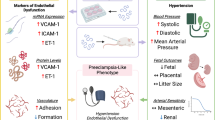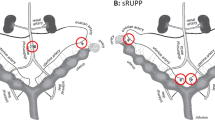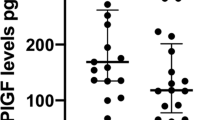Abstract
Impaired materno-placental perfusion causes two important obstetric complications, fetal growth restriction and preeclampsia. This study investigated whether adenoviral vector-mediated overexpression of vascular endothelial growth factor (VEGF) in the uterine arteries (UtAs) increases uterine artery blood flow (UBF). First-generation adenovirus vectors (5 × 1011 particles) containing the VEGF gene (Ad.VEGF-A or -D) or the β-galactosidase reporter gene (Ad.lacZ) were injected into the UtAs of pregnant sheep (n=6) at 88–102 days of gestation (term=145 days). UBF was measured using Doppler sonography before, and 4–7 days after injection. Mean UBF increased significantly from 233±156 (s.d.) ml min−1 to 753±415 ml min−1 following Ad.VEGF-A injection (P=0.005, n=5); Ad.lacZ infection had no significant effect. Organ bath experiments on uterine arterial sections 4–7 days after injection showed that, compared with Ad.lacZ vessels, Ad.VEGF-A-transduced vessels had a reduced contractile response to phenylephrine (Emax 148±10.9 vs Emax 228.2±27.5, P<0.05) but increased relaxation with bradykinin (pD2 (−log EC50) values 9.11±0.01 vs 8.65±0.11, P<0.05). Injection of Ad.VEGF-A into the UtAs increases UBF by enhancing vasodilatation. This may provide the basis for therapy in pregnancies complicated by uteroplacental insufficiency.
This is a preview of subscription content, access via your institution
Access options
Subscribe to this journal
Receive 12 print issues and online access
$259.00 per year
only $21.58 per issue
Buy this article
- Purchase on Springer Link
- Instant access to full article PDF
Prices may be subject to local taxes which are calculated during checkout




Similar content being viewed by others
Accession codes
References
Lang U, Baker SR, Braems G, Zygmunt M, Kunzel W, Clarke WE . Uterine blood flow—a determinant of fetal growth. Eur J Obstet Gynecol Reprod Biol 2003; 110: S55–S61.
Sibhai B, Dekker G, Kupferminc M . Pre-eclampsia. Lancet 2005; 365: 785–799.
Barker DJP . Adult consequences of fetal growth restriction. Clin Obstet Gynecol 2006; 49: 270–283.
Ochi H, Matsubara K, Kusanagi Y, Taniguchi H, Ito M . Significance of a diastolic notch in the uterine artery flow velocity waveform induced by uterine embolisation in the pregnant ewe. BJOG 1998; 105: 1118–1121.
Papageorghiou A, Yu CKH, Nicolaides KH . The role of uterine artery Doppler in predicting adverse pregnancy outcome. Best Pract Res Clin Obstet Gynaecol 2004; 18: 383–396.
Naicker T, Khedun SM, Moodley J, Pijnenborg R . Quantitaive analysis of trophoblast invasion in pre-eclampsia. Acta Obstet Gynecol Scand 2003; 82: 772–779.
Reister F, Frank HG, Kingdom JC . Macrophage-induced apoptosis limits endovascular trophoblast invasion in the uterine walls of preeclamptic women. Lab Invest 2001; 81: 1142–1152.
Ong SS, Baker PN, Mayhew TM, Dunn WR . Remodeling of myometrial radial arteries in pre-eclampsia. Am J Obst Gynecol 2005; 192: 572–579.
Wareing M, Myers JE, O'Hara M, Baker PN . Sildenafil citrate enhances vasodilatation in fetal growth restriction. J Clin Endocrinol Metab 2005; 90: 2550–2555.
Carmeliet P, Jain R . Angiogenesis in health and disease. Nat Med 2003; 9: 653–660.
Zachary I, Mathur A, Ylä-Herttuala S, Martin JF . A novel nonangiogenic cardiovascular role for VEGF. Arterioscler Thromb Vasc Biol 2000; 20: 1512–1520.
Simons M, Bonow RO, Chronos NA, Cohen DJ, Giordano FJ, Hammond HK et al. Clinical trials in coronary angiogenesis: issues, problems, consensus: an expert panel summary. Circulation 2000; 102: E73–E86.
Ylä-Herttuala S, Martin JF . Cardiovascular gene therapy. Lancet 2000; 355: 213–222.
Khurana R, Martin JF, Zachary I . Gene therapy for cardiovascular disease. A case for cautious optimism. Hypertension 2001; 38: 1210–1216.
Ku DD, Zaleski JK, Liu S, Brock TA . Vascular endothelial growth factor induces EDRF-dependent relaxation in coronary arteries. Am J Physiol 1993; 265: H586–H592.
Takeshita SS, Isshiki T, Ochiai M, Eto K, Mori H, Tanaka E et al. Endothelium-dependent relaxation of collateral microvessels after intramuscular gene transfer of vascular endothelial growth factor in a rat model of hindlimb ischemia. Circulation 1998; 98: 1261–1263.
Laitinen M, Zachary I, Breier G, Pakkanen T, Hakkinen T, Luoma J et al. VEGF gene transfer reduces intimal thickening via increased production of nitric oxide in carotid arteries. Hum Gene Ther 1997; 8: 1737–1744.
Wheeler-Jones C, Abu-Ghazaleh R, Cospedal R, Houliston RA, Martin JF, Zachary I . Vascular endothelial growth factor stimulates prostacyclin production and activation of cytosolic phospholipase A2 in endothelial cells via p42/p44 mitogen-activated protein kinase. FEBS Lett 1997; 420: 28–32.
Horowitz JR, Rivard A, van der Zee R, Hariawala M, Sheriff DD, Esakof DD et al. Vascular endothelial growth factor/vascular permeability factor produces nitric oxide-dependent hypotension. Evidence for a maintenance role in quiescent adult endothelium. Arterioscler Thromb Vasc Biol 1997; 17: 2793–2800.
Li B, Ogasawara AK, Yang R, Wei W, He GW, Zioncheck TF et al. KDR (VEGF receptor 2) is the major mediator for the hypotensive effect of VEGF. Hypertension 2002; 39: 1095–1100.
Khurana R, Zhuang Z, Bhardwaj S, Murakami M, De Muinck E, Ylä-Herttuala S et al. Angiogenesis-dependent and independent phases of intimal hyperplasia. Circulation 2004; 110: 2436–2443.
Peebles DM, Miller S, Newman JP, Scott R, Hanson MA . The effect of systemic administration of lipopolysaccharide on cerebral haemodynamics and oxygenation in the 0.65 gestation ovine fetus in utero. BJOG 2003; 110: 735–743.
Konje JC, Kaufmann P, Bell SC, Taylor DJ . A longitudinal study of quantitative uterine blood flow with the use of color power angiography in appropriate for gestational age pregnancies. Am J Obstet Gynecol 2001; 185: 608–613.
Acharya G, Sitras V, Erkinaro T, Mäkikallio K, Kavasmaa T, Päkkilä M et al. Experimental validation of uterine artery volume blood flow measurement by Doppler ultrasonography in pregnant sheep. Ultrasound Obstet Gynecol 2007; 29: 401–406.
Abadie Y, Bregeon F, Papazian L, Lange F, Chailley-Heu B, Thomas P et al. Decreased VEGF concentration in lung tissue and vascular injury during ARDS. Eur Respir J 2005; 25: 139–146.
Khurana R, Shafi S, Martin J, Zachary I . Vascular endothelial growth factor gene transfer inhibits neointimal macrophage accumulation in hypercholesterolemic rabbits. Arterioscler Thromb Vasc Biol 2004; 24: 1074–1080.
David AL, Cook T, Waddington S, Peebles D, Nivsarkar M, Knapton H et al. Ultrasound guided percutaneous delivery of adenoviral vectors encoding the β-galactosidase and human factor IX genes to early gestation fetal sheep in utero. Hum Gene Ther 2003; 14: 353–364.
Torondel B, Vila JM, Segarra G, Lluch P, Medina P, Martinez-Leon J et al. Endothelium-dependent responses in human isolated thyroid arteries from donors. J Endocrinol 2004; 181: 379–384.
Schauf B, Mannschreck B, Becker S, Dietz K, Wallwiener D, Aydeniz B . Evaluation of red blood cell deformability and uterine blood flow in pregnant women with preeclampsia or iugr and reduced uterine blood flow following the intravenous application of magnesium. Hypertens in Pregnancy 2004; 23: 331–343.
Lundell A, Bergquist E, Mattsson E, Nilsson B . Volume blood flow measurements with transit time flometer: an in vivo and in vitro variability and validation study. Clin Physiol 1993; 13: 547–557.
Konje JC, Howarth ES, Kaufmann P, Taylor DJ . Longitudinal quantification of uterine artery blood volume flow changes during gestation in pregnancies complicated by intrauterine growth restriction. BJOG 2003; 110: 301–305.
Henry TD, Annex BH, McKendall GR, Azrin MA, Lopez JJ, Giordano FJ et al. The VIVA trial: vascular endothelial growth factor in ischemia for vascular angiogenesis. Circulation 2003; 107: 1359–1365.
Heikkilä A, Hiltunen MO, Turunen MP, Keski-Nisula L, Turunen A-M, Räsänen H et al. Angiographically guided utero-placental gene transfer in rabbits with adenoviruses, plasmid/liposomes and plasmid/polyethyleneimine complexes. Gene Therapy 2001; 8: 784–788.
Costeloe K, Hennessy EM, Gibson AT, Marlow N, Wilkinson AR . The EPICure Study: outcomes to discharge from hospital for infants born at the threshold of viability. Pediatrics 2000; 106: 659–679.
Tommiska V, Heinonen K, Ikonen S, Kero P, Pokela ML, Renlund M et al. Born in Finland in 1996–1997. A national short-term follow-up study of extremely low birth weight infants. Pediatrics 2001; 107: E2.
Marlow N, Wolke D, Bracewell MA, Samara M . Neurologic and developmental disability at six years of age after extremely preterm birth. N Engl J Med 2006; 352: 9–19.
Morse SB, Wu SS, Ma C, Ariet M, Resnick M, Roth J . Racial and gender differences in the viability of extremely low birth weight infants: a population-based study. Pediatrics 2006; 117: e106–e112.
Vedantham S, Goodwin SC, McLucas B, Mohr G . Uterine artery embolization: an underused method of controlling pelvic hemorrhage. Am J Obstet Gynecol 1997; 176: 938–948.
Acknowledgements
We are grateful to Ark Therapeutics for supply of reagents, Simon Waddington (Department of Haematology, Haemophilia Centre and Haemostasis Unit, Royal Free and University College Medical School) for data analysis and statistical assistance, Helena Viita (Ark Therapeutics Oy, Kuopio, Finland) and Manfred Ramirez (Rayne Institute, University College London) for technical assistance; John Martin is Professor of Cardiovascular Science at British Heart Foundation. This work was undertaken at UCLH/UCL who received a proportion of funding from the Department of Health's NIHR Biomedical Research Centres funding scheme.
Author information
Authors and Affiliations
Corresponding author
Rights and permissions
About this article
Cite this article
David, A., Torondel, B., Zachary, I. et al. Local delivery of VEGF adenovirus to the uterine artery increases vasorelaxation and uterine blood flow in the pregnant sheep. Gene Ther 15, 1344–1350 (2008). https://doi.org/10.1038/gt.2008.102
Received:
Revised:
Accepted:
Published:
Issue Date:
DOI: https://doi.org/10.1038/gt.2008.102
Keywords
This article is cited by
-
Seasonal vascular plasticity in the mediobasal hypothalamus of the adult ewe
Histochemistry and Cell Biology (2022)
-
Placental Origins of Preeclampsia: Potential Therapeutic Targets
Current Medical Science (2019)
-
EVERREST prospective study: a 6-year prospective study to define the clinical and biological characteristics of pregnancies affected by severe early onset fetal growth restriction
BMC Pregnancy and Childbirth (2017)
-
Early onset fetal growth restriction
Maternal Health, Neonatology and Perinatology (2017)
-
Long-term increase in uterine blood flow is achieved by local overexpression of VEGF-A165 in the uterine arteries of pregnant sheep
Gene Therapy (2012)



